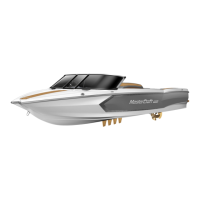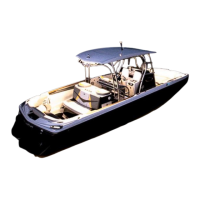STORAGE/ WINTERIZATION
21-2
Step 4: Carefully loosen the flame arrestor and lift it far enough to insert the tube of the fogging oil can. Spray
four to six (4 to 6) ounces of oil into the throat of the carburetor or throttle body. Shut off the engine. Re-attach
the flame arrestor and seal with low-tack tape.
Step 5: Perform the annual maintenance as described in the previous chapter.
Step 6: Loosen all accessory drive belts and check their condition.
All Engines
Step 1: Drain water from the exhaust manifolds. Uncouple the hose quick-disconnect and drain the manifolds.
The engine manufacturer recommends leaving the drain plugs out or the hose uncoupled until the boat is placed
back in service.
Step 2: Remove both hoses from the raw water pump on
the front of the engine. Drain any remaining water from the
hoses.
Step 3: Remove the raw water pump impeller from the
pump housing. If the impeller shows any signs of damage or
wear, discard it. If it can be re-used, lubricate the impeller
with Vasoline or soap and seal in an airtight bag.
Note: It is extremely important to pay attention to the impeller
during use. At any sign of wear, replace it. If you have used a
single impeller throughout the season, replace it. Be certain that
when the boat is placed in service the following season that you
have an impeller in the raw water pump! Failure to follow these
guidelines may result in nullifying your warranty!
Step 4: Remove the hose from the lower end of the trans-
mission cooler. Inspect the cooler for any debris such as weeds, plastic
pieces, etc.
Raw Water-Cooled Engines
Step 1: Remove the petcock, drain plug or sensor from each side of the
engine. The engine manufacturer recommends removing the petcocks
completely as opposed to simply opening the petcock drain valve.
Notice: Some 5.7 Liter engines have a knock sensor located in
the drain location. The knock sensor must be carefully removed to
drain that side of the block. Also, on the 8.1 Liter engine, removing
the knock sensor does NOT drain the block. Remove the plugs
from the brass fillings on both sides of the engine to drain water
from the block.
Running the engine with the flame arrestor removed in-
creases the possibility of fire or explosion if the engine
should backfire and gasoline fumes are present. If the en-
gine is operated without the flame arrestor secured, extreme
care must be taken to ensure that the engine compartment is
well-ventilated and that no fuel leaks are present.

